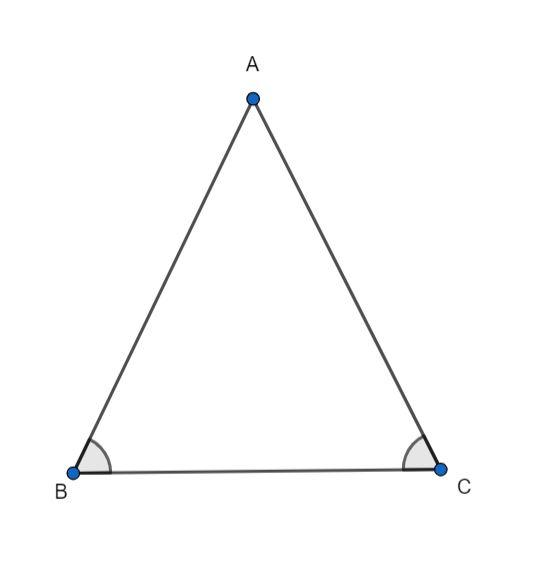
What is the relation between sides opposite to equal angles?
(a) Equal
(b) Unequal
(c) May or may not be equal
(d) None of these
Answer
606.3k+ views
Hint: Construct an angle bisector from the vertex where the sides opposite to equal angles intersect and then using the properties of congruence of triangle, determine the relation between these two sides.
Complete step-by-step answer:

Consider triangle ABC, where angle B and angle C are equal. We need to determine the relation between sides AC and AB which are opposite to the angles B and C respectively.
It is given that angle B and angle C are equal, hence, we have:
\[\angle ABC = \angle ACB............(1)\]
We can determine the relation between sides AB and AC by constructing an angle bisector from vertex A and considering the resulting two triangles.
We draw an angle bisector AD from vertex A to intersect BC at D. Now, we have two triangles, triangle ADB and triangle ADC.

Let us check the triangles ADC and ADB for congruency.
We know that angle ABC is equal to angle ABD and angle ACB is equal to angle ACD.
\[\angle ABD = \angle ABC...........(2)\]
\[\angle ACD = \angle ACB...........(3)\]
Using equation (2) and (3) in equation (1), we have:
\[\angle ABD = \angle ACD...........(4)\]
Since, AD is the angular bisector, it divides angle A into equal angles as follows:
\[\angle BAD = \angle CAD...........(5)\]
The side AD is common to both the triangles. Hence, we have:
\[AD = AD...........(6)\]
From equations (4), (5) and (6), we observe that the two triangles are congruent by AAS (Angle-Angle-Side) criterion.
\[\Delta ABD = \Delta ACD {\text{ (AAS - criterion)}}\]
We know that the ratio of the corresponding sides of congruent triangles are equal.
\[\dfrac{{AB}}{{AC}} = \dfrac{{BD}}{{CD}} = \dfrac{{AD}}{{AD}}\]
Considering the first and the last term, we have:
\[\dfrac{{AB}}{{AC}} = \dfrac{{AD}}{{AD}} = 1\]
\[AB = AC\]
Hence, the two sides are equal.
Hence, the correct answer is option (a).
Note: You may make a mistake if you try to construct a median from the vertex joining the sides opposite to equal angles and try to prove congruence between resulting triangles by SSA criterion, which does not exist for proving congruence between two triangles.
Complete step-by-step answer:

Consider triangle ABC, where angle B and angle C are equal. We need to determine the relation between sides AC and AB which are opposite to the angles B and C respectively.
It is given that angle B and angle C are equal, hence, we have:
\[\angle ABC = \angle ACB............(1)\]
We can determine the relation between sides AB and AC by constructing an angle bisector from vertex A and considering the resulting two triangles.
We draw an angle bisector AD from vertex A to intersect BC at D. Now, we have two triangles, triangle ADB and triangle ADC.

Let us check the triangles ADC and ADB for congruency.
We know that angle ABC is equal to angle ABD and angle ACB is equal to angle ACD.
\[\angle ABD = \angle ABC...........(2)\]
\[\angle ACD = \angle ACB...........(3)\]
Using equation (2) and (3) in equation (1), we have:
\[\angle ABD = \angle ACD...........(4)\]
Since, AD is the angular bisector, it divides angle A into equal angles as follows:
\[\angle BAD = \angle CAD...........(5)\]
The side AD is common to both the triangles. Hence, we have:
\[AD = AD...........(6)\]
From equations (4), (5) and (6), we observe that the two triangles are congruent by AAS (Angle-Angle-Side) criterion.
\[\Delta ABD = \Delta ACD {\text{ (AAS - criterion)}}\]
We know that the ratio of the corresponding sides of congruent triangles are equal.
\[\dfrac{{AB}}{{AC}} = \dfrac{{BD}}{{CD}} = \dfrac{{AD}}{{AD}}\]
Considering the first and the last term, we have:
\[\dfrac{{AB}}{{AC}} = \dfrac{{AD}}{{AD}} = 1\]
\[AB = AC\]
Hence, the two sides are equal.
Hence, the correct answer is option (a).
Note: You may make a mistake if you try to construct a median from the vertex joining the sides opposite to equal angles and try to prove congruence between resulting triangles by SSA criterion, which does not exist for proving congruence between two triangles.
Recently Updated Pages
Why are manures considered better than fertilizers class 11 biology CBSE

Find the coordinates of the midpoint of the line segment class 11 maths CBSE

Distinguish between static friction limiting friction class 11 physics CBSE

The Chairman of the constituent Assembly was A Jawaharlal class 11 social science CBSE

The first National Commission on Labour NCL submitted class 11 social science CBSE

Number of all subshell of n + l 7 is A 4 B 5 C 6 D class 11 chemistry CBSE

Trending doubts
What is meant by exothermic and endothermic reactions class 11 chemistry CBSE

10 examples of friction in our daily life

One Metric ton is equal to kg A 10000 B 1000 C 100 class 11 physics CBSE

1 Quintal is equal to a 110 kg b 10 kg c 100kg d 1000 class 11 physics CBSE

Difference Between Prokaryotic Cells and Eukaryotic Cells

What are Quantum numbers Explain the quantum number class 11 chemistry CBSE




